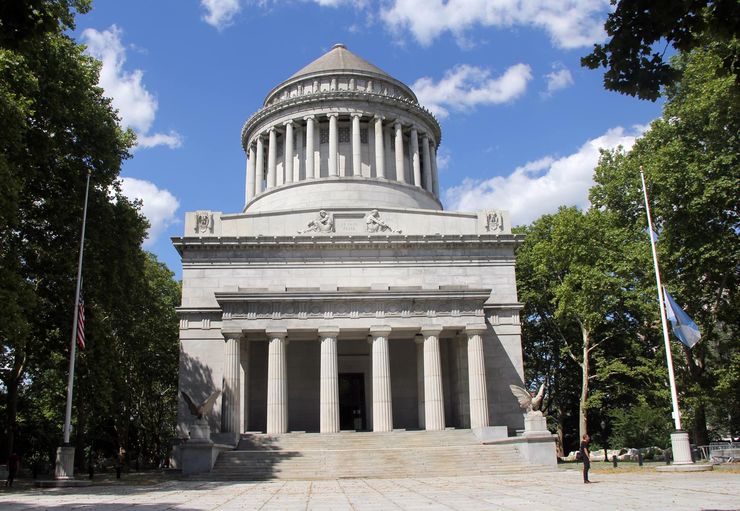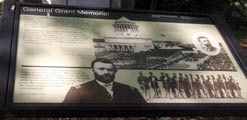
 The General Grant National Memorial, commonly called
Grant's Tomb: The resting place of and monument to Ulysses S. Grant,
commanding General of the US Army in the Civil War and two-term President,
in Riverside Park at West 123rd Street, the
largest mausoleum in America according to the National Park Service sign at
the site (click image). Completed in 1897.
By 1935 it was badly in need of repairs. A New York City Parks Department
press release of October 7, 1937[2] says:
The General Grant National Memorial, commonly called
Grant's Tomb: The resting place of and monument to Ulysses S. Grant,
commanding General of the US Army in the Civil War and two-term President,
in Riverside Park at West 123rd Street, the
largest mausoleum in America according to the National Park Service sign at
the site (click image). Completed in 1897.
By 1935 it was badly in need of repairs. A New York City Parks Department
press release of October 7, 1937[2] says:
On October 15th, work in connection with the renovation of Grant's Tomb, which was dedicated in 1897, will be completed by the monument restoration group of the Park Department. The entire interior has been cleaned and worn floors and broken carved marble have been restored. The exterior of the structure has been waterproofed.Moreover, the Grant's Tomb website[3] itelf notes that:
In 1938 ... a number of developments were pursued with support of the WPA:Ralph Gardner writes in the Wall Street Journal[4]:
- Installation of busts in the crypt depicting Grant's most esteemed lieutenants during the Civil War.
- Artist Dean Fausett paints murals in both reliquary rooms featuring allegorical figures and the Civil War theater, with locations of Grant's battles highlighted.
- Re-landscaping and modifying of the surrounding plaza.
The tomb, designed by John Duncan and based on an ancient Greek mausoleum, is relatively stark without being uninviting. Natural light streams through high amber glass windows. There are two small reliquary rooms off the rotunda bearing battle flags, and the crypt is decorated with busts, added during the 1930s as part of a WPA project, of Grant's generals, among them Phillip Sheridan and William Sherman.The Riverside Park Conservancy adds[5]:
Over the years, sculptural embellishments and accents were added to the memorial: bronze busts of Grants generals were sculpted as part of a Works Progress Administration Program in 1938. Murals of Grant's battles were painted on the interior walls around the same time.David M. Kahn of the National Park Service goes into greater detail[6]:
Thirty-eight years after the tomb opened, the initial restoration project began in December 1935, when the Works Progress Administration's laborers laid down new marble flooring in the atrium. In 1935-39 WPA cleaned marble (interior and exterior), replaced floors, replaced roof, electric lighting, heating, built curator's office, new stained glass, painted over dirty plaster walls, screens, display racks, brass sculptured busts of five Union generals by WPA artists, installation of eagles on the parapet, expansion and landscaping of surrounding parkland and addition of granite stairs and retaining walls [designed by Gilmore D. Clarke and Aymar Embury, Robert Moses' CWA-WPA-paid chief architects], new trees, two flagpoles with brass plaques, expanded plaza, ... “In January 1939, most of the WPA laborers had largely completed their work and a ceremony was held at the tomb during which they were given certificates of commendation by the [Grant Monument] Association. A formal rededication of the tomb, attended by a few Civil War veterans among others, was then held on April 27, 1939. The entire project had cost some $300,000 of which the Grant Monument Association has supplied over $80,000 left over from the fund raising campaign of 1929. The tomb looked fresher inside and out than it had in years.” ...Shortly after the restoration project began, the old New York City Post Office was being demolished and donated two statues of eagles to decorate the front of the Grant Monument. The laborers of the WPA worked on several projects throughout the 1930s, including roof restoration, electric lighting and heating systems, and removing the purple stained glass windows. The Pittsburgh Plate Glass Company installed amber glass to replace the purple stained glass. Toward the end of the 1930s, a project began to restore the two reliquary rooms, where battle flags were displayed in trophy cases, and murals of the wars Grant had fought in were painted on the walls. In 1938 the Federal Art Project selected artists William Mues and Jeno Juszko to design the busts of William T. Sherman, Phillip H. Sheridan, George H. Thomas, James B. McPherson, and Edward Ord. The WPA installed five busts in the circular wall of the atrium surrounding the sarcophagi. After the many contributions of the WPA, the Grant Monument Association held a re-dedication of the tomb on April 27, 1939.
References:
- General Grant National Monument website at the National Park Service.
- NYC Parks Dept press release of October 11, 1937
- Grant's Tomb History at www.grantstomb.org, the website of the Grant Monument Association.
- Gardner, Ralph Jr., Seeing Grant's Tomb in a New Light, Wall Street Journal, February 23, 2015.
- General Grant National Memorial (Grant's Tomb) at riversideparknyc.org, the website of the Riverside Park Conservancy
- Kahn, David M., Curator, Manhattan Cities, General Grant National Memorial: Historical Resource Study, January 1980 (National Park Service), pp.164-174.
- Waugh, Joan, U. S. Grant: American Hero, American Myth, University of North Carolina Press (2009).